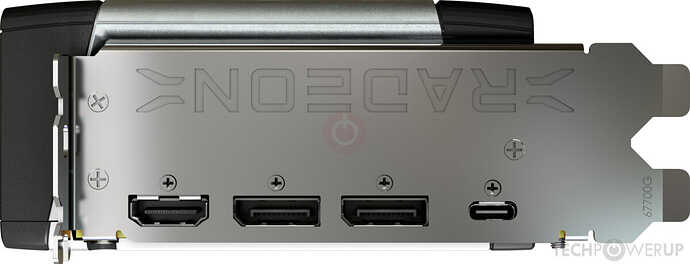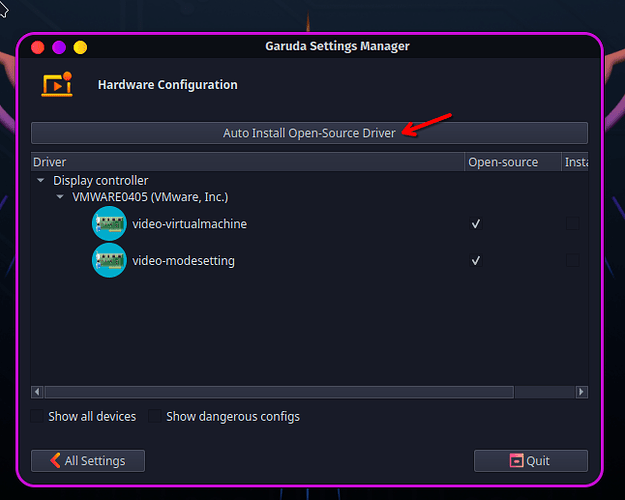Hello,
I have recently installed Garuda Linux Dragonized to daily drive for a while in preparation for moving away from windows post windows 10 support later this year. Not new to linux, have used rasperry pis, linux mint etc through the years but this is first real experience with Arch outside of the Steam deck.
I have a 1440p 120Hz Freesync HDR monitor(BenQ EX3203R) that works happily in windows but is only working at 100Hz for me Linux. Would like to get it working to the same standard on Linux(except for the HDR as I get that’s still poorly supported at this time).
Key points:
- I only get an option for 60Hz in the settings by normal in either X11 or Wayland
- Have got it to work at 100Hz in X11 using these commands:
cvt 2560 1440 100
xrandr --newmode "2560x1440_100.00" 542.25 2560 2776 3056 3552 1440 1443 1448 1527 -hsync +vsync
xrandr --addmode DisplayPort-2 "2560x1440_100.00"
Attempting to get 120Hz with this method just results in a black screen. Using glxgears confirms the monitor is running at 100Hz after this.
- Have tried switching to LTS kernel instead of Zen but it made no difference.
- Based on the variable refresh rate page in the arch Linux Wiki I have the following 20-amdgpu.conf:
Section "OutputClass"
Identifier "AMD"
MatchDriver "amdgpu"
Driver "amdgpu"
Option "VariableRefresh" "true"
Option "AsyncFlipSecondaries" "true"
Option "TearFree" "true"
EndSection
Any recommendations what I could do to resolve this?
Bonus Questions:
- Can’t seem to get freesync to work either(“
systool -vm amdgpu | grep free” returns ‘freesync_video = "0"’)
- vrrTest also confirmed variable refresh rate is not working - Wayland causes another issue where I get a free seconds of a black screen in game menus & when I pause or alt-tab. Perhaps if that could be solved maybe wayland would work fully then?
Thanks in advance.
Garuda-Inxi:
System:
Kernel: 6.13.7-zen1-1-zen arch: x86_64 bits: 64 compiler: gcc v: 14.2.1 clocksource: tsc
avail: hpet,acpi_pm parameters: BOOT_IMAGE=/@/boot/vmlinuz-linux-zen
root=UUID=796024b3-9ab7-49d8-a1cb-26da85642225 rw rootflags=subvol=@ quiet loglevel=3 ibt=off
Desktop: KDE Plasma v: 6.3.3 tk: Qt v: N/A info: frameworks v: 6.12.0 wm: kwin_x11 vt: 2
dm: SDDM Distro: Garuda base: Arch Linux
Machine:
Type: Desktop Mobo: ASUSTeK model: ROG STRIX B450-E GAMING v: Rev 1.xx
serial: <superuser required> part-nu: SKU uuid: <superuser required> UEFI: American Megatrends
v: 5302 date: 10/20/2023
CPU:
Info: model: AMD Ryzen 7 5800X bits: 64 type: MT MCP arch: Zen 3+ gen: 3 level: v3 note: check
built: 2022 process: TSMC n6 (7nm) family: 0x19 (25) model-id: 0x21 (33) stepping: 2
microcode: 0xA201210
Topology: cpus: 1x dies: 1 clusters: 1 cores: 8 threads: 16 tpc: 2 smt: enabled cache:
L1: 512 KiB desc: d-8x32 KiB; i-8x32 KiB L2: 4 MiB desc: 8x512 KiB L3: 32 MiB desc: 1x32 MiB
Speed (MHz): avg: 4191 min/max: 550/4851 boost: enabled scaling: driver: amd-pstate-epp
governor: powersave cores: 1: 4191 2: 4191 3: 4191 4: 4191 5: 4191 6: 4191 7: 4191 8: 4191
9: 4191 10: 4191 11: 4191 12: 4191 13: 4191 14: 4191 15: 4191 16: 4191 bogomips: 121598
Flags: avx avx2 ht lm nx pae sse sse2 sse3 sse4_1 sse4_2 sse4a ssse3 svm
Vulnerabilities: <filter>
Graphics:
Device-1: Advanced Micro Devices [AMD/ATI] Navi 21 [Radeon RX 6800/6800 XT / 6900 XT]
driver: amdgpu v: kernel arch: RDNA-2 code: Navi-2x process: TSMC n7 (7nm) built: 2020-22 pcie:
gen: 4 speed: 16 GT/s lanes: 16 ports: active: DP-1,DP-3 empty: DP-2,HDMI-A-1,Writeback-1
bus-ID: 0c:00.0 chip-ID: 1002:73bf class-ID: 0300
Device-2: Microdia Webcam Vitade AF driver: snd-usb-audio,uvcvideo type: USB rev: 2.0
speed: 480 Mb/s lanes: 1 mode: 2.0 bus-ID: 1-6:4 chip-ID: 0c45:6366 class-ID: 0102
serial: <filter>
Display: x11 server: X.Org v: 21.1.16 with: Xwayland v: 24.1.6 compositor: kwin_x11 driver: X:
loaded: amdgpu unloaded: modesetting,radeon alternate: fbdev,vesa dri: radeonsi gpu: amdgpu
display-ID: :0 screens: 1
Screen-1: 0 s-res: 4000x2560 s-dpi: 96 s-size: 1058x677mm (41.65x26.65")
s-diag: 1256mm (49.45")
Monitor-1: DP-1 mapped: DisplayPort-0 pos: top-right model: Idek Iiyama PL2783Q
serial: <filter> built: 2018 res: mode: 2560x1440 hz: 60 scale: 177% (0.5625) to: 1440x2560
dpi: 109 gamma: 1.2 size: 597x336mm (23.5x13.23") diag: 685mm (27") ratio: 16:9 modes:
max: 2560x1440 min: 640x480
Monitor-2: DP-3 mapped: DisplayPort-2 pos: primary,bottom-l model: BenQ EX3203R
serial: <filter> built: 2020 res: mode: 2560x1440_100.00 hz: 100 scale: 100% (1) dpi: 93
gamma: 1.2 size: 698x393mm (27.48x15.47") diag: 801mm (31.5") ratio: 16:9 modes: max: 2560x1440
min: 720x400
API: EGL v: 1.5 hw: drv: amd radeonsi platforms: device: 0 drv: radeonsi device: 1 drv: swrast
gbm: drv: kms_swrast surfaceless: drv: radeonsi x11: drv: radeonsi inactive: wayland
API: OpenGL v: 4.6 compat-v: 4.5 vendor: amd mesa v: 25.0.1-arch1.2 glx-v: 1.4
direct-render: yes renderer: AMD Radeon RX 6800 (radeonsi navi21 LLVM 19.1.7 DRM 3.61
6.13.7-zen1-1-zen) device-ID: 1002:73bf memory: 15.62 GiB unified: no
API: Vulkan v: 1.4.304 layers: 12 device: 0 type: discrete-gpu name: AMD Radeon RX 6800 (RADV
NAVI21) driver: N/A device-ID: 1002:73bf surfaces: xcb,xlib device: 1 type: cpu name: llvmpipe
(LLVM 19.1.7 256 bits) driver: N/A device-ID: 10005:0000 surfaces: xcb,xlib
Info: Tools: api: clinfo, eglinfo, glxinfo, vulkaninfo de: kscreen-console,kscreen-doctor
gpu: corectrl,lact wl: wayland-info x11: xdpyinfo, xprop, xrandr
Audio:
Device-1: Advanced Micro Devices [AMD/ATI] Navi 21/23 HDMI/DP Audio driver: snd_hda_intel
v: kernel pcie: gen: 4 speed: 16 GT/s lanes: 16 bus-ID: 0c:00.1 chip-ID: 1002:ab28 class-ID: 0403
Device-2: Advanced Micro Devices [AMD] Starship/Matisse HD Audio vendor: ASUSTeK
driver: snd_hda_intel v: kernel pcie: gen: 4 speed: 16 GT/s lanes: 16 bus-ID: 0f:00.4
chip-ID: 1022:1487 class-ID: 0403
Device-3: Jieli OW810 driver: hid-generic,snd-usb-audio,usbhid type: USB rev: 1.1
speed: 12 Mb/s lanes: 1 mode: 1.1 bus-ID: 1-5:3 chip-ID: 4c4a:4155 class-ID: 0300
serial: <filter>
Device-4: Microdia Webcam Vitade AF driver: snd-usb-audio,uvcvideo type: USB rev: 2.0
speed: 480 Mb/s lanes: 1 mode: 2.0 bus-ID: 1-6:4 chip-ID: 0c45:6366 class-ID: 0102
serial: <filter>
API: ALSA v: k6.13.7-zen1-1-zen status: kernel-api with: aoss type: oss-emulator tools: N/A
Server-1: PipeWire v: 1.4.1 status: active with: 1: pipewire-pulse status: active
2: wireplumber status: active 3: pipewire-alsa type: plugin 4: pw-jack type: plugin
tools: pactl,pw-cat,pw-cli,wpctl
Network:
Device-1: Intel I211 Gigabit Network vendor: ASUSTeK driver: igb v: kernel pcie: gen: 1
speed: 2.5 GT/s lanes: 1 port: e000 bus-ID: 04:00.0 chip-ID: 8086:1539 class-ID: 0200
IF: enp4s0 state: up speed: 1000 Mbps duplex: full mac: <filter>
Device-2: Intel Wi-Fi 5 Wireless-AC 9x6x [Thunder Peak] driver: iwlwifi v: kernel pcie: gen: 2
speed: 5 GT/s lanes: 1 bus-ID: 05:00.0 chip-ID: 8086:2526 class-ID: 0280
IF: wlp5s0 state: up mac: <filter>
Info: services: NetworkManager, smbd, systemd-timesyncd, wpa_supplicant
Bluetooth:
Device-1: Intel Wireless-AC 9260 Bluetooth Adapter driver: btusb v: 0.8 type: USB rev: 2.0
speed: 12 Mb/s lanes: 1 mode: 1.1 bus-ID: 1-9:6 chip-ID: 8087:0025 class-ID: e001
Report: btmgmt ID: hci0 rfk-id: 0 state: up address: <filter> bt-v: 5.1 lmp-v: 10 status:
discoverable: no pairing: no class-ID: 6c0104
Drives:
Local Storage: total: 5 TiB used: 229.96 GiB (4.5%)
SMART Message: Unable to run smartctl. Root privileges required.
ID-1: /dev/nvme0n1 maj-min: 259:0 vendor: Western Digital model: WD BLACK SN770 1TB
size: 931.51 GiB block-size: physical: 512 B logical: 512 B speed: 63.2 Gb/s lanes: 4 tech: SSD
serial: <filter> fw-rev: 731030WD temp: 46.9 C scheme: GPT
ID-2: /dev/nvme1n1 maj-min: 259:4 vendor: Crucial model: CT500P2SSD8 size: 465.76 GiB
block-size: physical: 512 B logical: 512 B speed: 31.6 Gb/s lanes: 4 tech: SSD serial: <filter>
fw-rev: P2CR012 temp: 33.9 C scheme: GPT
ID-3: /dev/sda maj-min: 8:0 vendor: Crucial model: CT2000BX500SSD1 size: 1.82 TiB block-size:
physical: 512 B logical: 512 B speed: 6.0 Gb/s tech: SSD serial: <filter> fw-rev: 061 scheme: MBR
ID-4: /dev/sdb maj-min: 8:16 vendor: Western Digital model: WD10EZEX-00BN5A0 size: 931.51 GiB
block-size: physical: 4096 B logical: 512 B speed: 6.0 Gb/s tech: HDD rpm: 7200 serial: <filter>
fw-rev: 1A01 scheme: GPT
ID-5: /dev/sdc maj-min: 8:32 vendor: Samsung model: SSD 860 EVO 1TB size: 931.51 GiB
block-size: physical: 512 B logical: 512 B speed: 6.0 Gb/s tech: SSD serial: <filter>
fw-rev: 3B6Q scheme: GPT
Partition:
ID-1: / raw-size: 316.83 GiB size: 316.83 GiB (100.00%) used: 229.96 GiB (72.6%) fs: btrfs
dev: /dev/sda5 maj-min: 8:5
ID-2: /boot/efi raw-size: 599 MiB size: 597.8 MiB (99.80%) used: 624 KiB (0.1%) fs: vfat
dev: /dev/nvme0n1p3 maj-min: 259:3
ID-3: /home raw-size: 316.83 GiB size: 316.83 GiB (100.00%) used: 229.96 GiB (72.6%) fs: btrfs
dev: /dev/sda5 maj-min: 8:5
ID-4: /var/log raw-size: 316.83 GiB size: 316.83 GiB (100.00%) used: 229.96 GiB (72.6%)
fs: btrfs dev: /dev/sda5 maj-min: 8:5
ID-5: /var/tmp raw-size: 316.83 GiB size: 316.83 GiB (100.00%) used: 229.96 GiB (72.6%)
fs: btrfs dev: /dev/sda5 maj-min: 8:5
Swap:
Kernel: swappiness: 133 (default 60) cache-pressure: 100 (default) zswap: no
ID-1: swap-1 type: zram size: 31.25 GiB used: 0 KiB (0.0%) priority: 100 comp: zstd
avail: lzo-rle,lzo,lz4,lz4hc,deflate,842 max-streams: 16 dev: /dev/zram0
Sensors:
System Temperatures: cpu: 61.0 C mobo: 44.0 C gpu: amdgpu temp: 60.0 C mem: 60.0 C
Fan Speeds (rpm): cpu: 933 case-1: 1125 case-2: 1115 case-3: 992 gpu: amdgpu fan: 569
Power: 12v: 10.14 5v: N/A 3.3v: N/A vbat: 3.18 gpu: amdgpu watts: 45.00
Info:
Memory: total: 32 GiB available: 31.25 GiB used: 7.81 GiB (25.0%)
Processes: 415 Power: uptime: 1h 5m states: freeze,mem,disk suspend: deep avail: s2idle
wakeups: 0 hibernate: platform avail: shutdown, reboot, suspend, test_resume image: 12.49 GiB
services: org_kde_powerdevil, power-profiles-daemon, upowerd Init: systemd v: 257
default: graphical tool: systemctl
Packages: pm: pacman pkgs: 1517 libs: 427 tools: octopi,paru Compilers: clang: 19.1.7
gcc: 14.2.1 Client: Unknown Client: garuda-rani inxi: 3.3.37
Garuda (2.7.2-1):
System install date: 2025-03-16
Last full system update: 2025-03-21 ↻
Is partially upgraded: No
Relevant software: snapper NetworkManager dracut
Windows dual boot: Probably (Run as root to verify)
Failed units:

